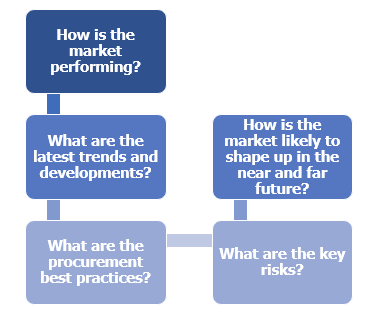Category Management Process
Engagement overview: The client, a market leader in the electronics industry, operating globally, wanted to develop a structured approach for the procurement of goods and services. As such, they wanted to implement the best techniques and tools to develop a strategic category management process. To successfully develop category management process steps, the electronics company approached SpendEdge to leverage its expertise in category management.
About the Client: One of the leading companies in the electronics industry.
Category Management Challenges
Navigating category management in the electronics industry presents multifaceted challenges. Continual technological advancements lead to rapidly evolving consumer preferences and product innovations. Synchronizing the right mix of devices, components, and accessories, while forecasting demand accurately, becomes intricate. Supplier partnerships are pivotal for sourcing reliable components and staying updated on emerging technologies. Striking a balance between offering cutting-edge products and maintaining cost efficiency requires astute planning. Managing categories across gadgets, components, and peripherals demands insightful market analysis, close collaboration with suppliers, and an ability to anticipate shifts in consumer electronics trends. Effective category management here involves harmonizing innovation, affordability, and market demand to drive customer engagement and brand loyalty.
Business Challenge:
The electronics industry is witnessing significant growth owing to the high demand for consumer electronic products. Hence, leading retailers in the electronics industry are looking at category management flow to help them reduce spend and boost returns. The client was encountering challenges in enhancing the efficiency of their procurement plan and, therefore, wanted to devise an effective category management process.
Summary of the category management process:

How did SpendEdge Help the Client with the Category Management Process?
The client joined hands with our experts to develop a category management process procurement that would help them enhance procurement efficiency. We developed a comprehensive approach that responds to the long-term procurement trends within the market.
While there are a number of ways in which category management can be implemented, there is an ongoing debate on the number of steps involved in a category management process – some say six, while others peg it at four, at SpendEdge, we follow a three-step approach.
- Step 1: Initiation
The initiation phase revolves around the creation of a category management plan, based on which the category management process will be developed. This initial phase of the category management process is a pre-requite and forms the foundation of every category management strategy.
- Step 2: Strategy creation
The next phase revolves around the development of a precise category strategy. Once the categories are assessed, it is essential to devise effective strategies that help deliver the category’s role. An external review of the electronics industry in India was carried out to identify key factors affecting the market.
- Step 3: Strategy implementation
The final step in category management deals with strategy implementation, it includes – evaluating the strategy plan, determining ROI, and assessing the impact of the process on the supply chain efficiency. However, the implementation of a dedicated category management process requires dedicated resources.
Benefits of the Engagement:
The three-step category management process enabled the client to gauge the performance of each category against their category management plan. Also, with the help of SpendEdge’s category management solutions, the client was able to study the global scenario of the electronics industry.
Importance of category management process
In today’s technologically progressive world, one can rely on high-end software for category management. However, the positioning and values of a brand are reflected through their capability to make strategic decisions that are in line with their business needs. Moreover, the internal alignment around the role of a category turns out to be very helpful in understanding consumer behavior towards the different categories. Effective category management allows electronic companies to optimize their product assortments by understanding customer preferences and market trends. This helps them offer the right mix of products that cater to different customer segments, leading to increased sales and customer satisfaction. The steps involved in a category management process may seem resource intensive, but when rightly done it can reduce wasteful spending and help brands compete more effectively.
Our Findings:
An effective category management process forms the basis of a robust category management system. It empowers organizations to devise effective strategies to enhance business value. If your organization is on the lookout for an objective way to promote category growth and procurement efficiency, category management is the ideal approach to identify alternative and feasible ways to enhance category growth.
The electronics industry globally is witnessing massive growth, as a result of which, the supply market challenges faced by the industry players are expected to multiply over the next few years. The burgeoning nature of such challenges necessitates the development of a category management process. This acts as an instrumental method for improving brand value while overturning the inertia that often sets in when businesses get confined to specific industry ethics.





